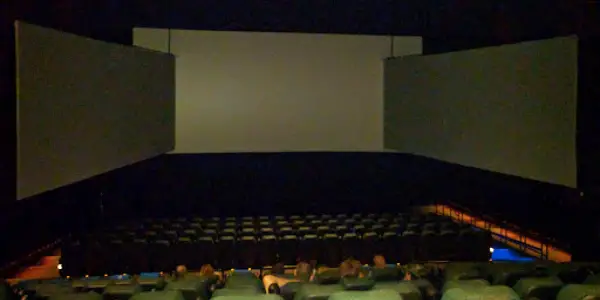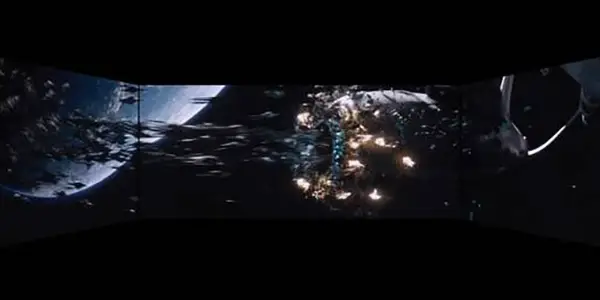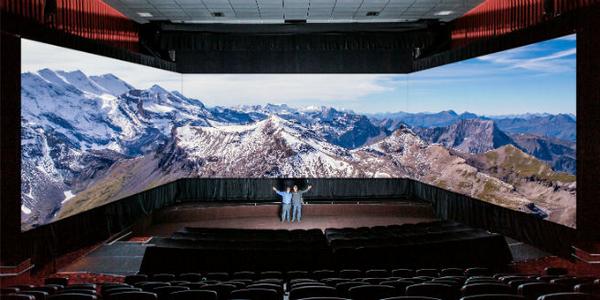When One Movie Screen Becomes Three: A Profile Of Barco Escape & STAR TREK BEYOND

Zachary is studying film at the University of Southern California,…
Belgian firm Barco recently made a move to present a new large-format viewing experience, alongside theater-chain in-house offerings, like Regal’s RPX premium experience, AMC Prime, Cinemark XD, and industry stalwarts like IMAX and RealD 3D. The Escape format uses three screens, with a center screen flat and straight ahead, like any conventional theater – the twist is the two side screens, angled, creating a viewing experience that gives the appearance of wrapping around the audience – a 270 degree panorama. With VR emerging on the scene right now, exhibitors will be looking for ways to provide new and different immersive viewing experiences.
It made its worldwide debut this past summer with the theatrical opening of the third Star Trek film, directed by Justin Lin, Star Trek Beyond. 30 films worldwide opened, showing Beyond with the new technology. I attended a preview screening of Beyond in the format, and before the film started, one of the film’s producers introduced it. He appeared on the center screen, then used his arms to push out to the other screens, explaining that certain moments in the film were designed with Barco Escape in mind, and in those scenes, the images will cover all three screens.
A Barco Innovation Center
My local theater, the Regal Cinemas at LA Live in Downtown Los Angeles, California, was recently overhauled. It opened not many years ago, but Barco Escape rolled in and purchased the naming rights for the theater. It is now the Barco Innovation Center at Regal LA Live. One theater was equipped with Barco Escape technology, and all theaters will eventually be equipped with their laser projectors. The lobby was outfitted with Barco Escape screens and lighting displays – they have what is, in essence, a showroom floor, to test their innovations, and show exhibitors and moviegoers what they can do.

In terms of my experience watching in Barco Escape, I wasn’t overly happy with it. Much like what most films do with IMAX, the film was altered in post-production to show in the format, as opposed to being shot for it. IMAX has been diluting their brand, and mainstream audiences haven’t seemed to notice: a film can be shot without using IMAX cameras, converted in post for IMAX exhibition, and no one (outside of the cine-literate) are the wiser. I anticipate the same thing happening with the Escape format.
The format has potential, but Beyond didn’t work in it. I have no doubt that, as more big blockbusters use the format, it will be improved. When the format was first promoted, I anticipated a rig being used for the Escape sequences, where three cameras could be positioned as the screens are, and would be rolling to effortlessly create a more immersive environment – when the screen shifts to showing full CG environments, this simply means more work in post-production, and that’s precisely the problem.
How Beyond Works in Barco Escape
This Hollywood Reporter piece details the efforts to ready Beyond for Barco Escape in post-production. They were working up to the last minute, and it negatively impacted the work. Since such a camera rig I hypothesized doesn’t yet exist, the process to prepare Beyond for the three-screen format included some CG set extensions. I myself noticed two kinds of scenes that utilized the extra screen space. The more effective of the two alternatives, which worked most of the time, were scenes that allowed the action to cover the three screens, particularly the large action sequences, and external shots of the spacecraft in flight.
The angling of the screens sometimes made it awkward in terms of staging (pre-production and pre-vis were not able to account for what would come later in post to accommodate Escape showings). The other type of scene using the extra screens was the real offender – the most glaringly unnecessary uses were the times when the side screens showed filler, as opposed to the moments when action spreads over them. An example of this is a scene featuring Spock and Kirk talking aboard the Enterprise, during the earlier part of the film. The center screen shows the conversation ongoing, while the two side screens show outer space whooshing by, as the Enterprise is moving at warp speed. This is completely unnecessary, and distracting.

While I noted that scenes spreading the action mostly worked, outside of awkwardness with the angling and framing, there is one enormous problem, that was likely caused by the rush to get the film ready for release in the format. If the scene partially or wholly consisted of CG visual effects, and was displayed on all three screens, the effects looked terrible. While walking out after the film, I ran into another audience member. I asked what he thought of the Escape format, and we both agreed it has potential, but he noted that the effects looked bad – I agreed on this as well.
I couldn’t imagine this film, the third in the current Trek series, could have such poor effects – they were remarkable in 2009’s Star Trek and 2013’s Star Trek Into Darkness (both directed by J.J. Abrams). The two of us realized that the scenes had to have been blown up/expanded to fill the three Escape screens, and this in turn would have hurt the effects, and overall image quality. The scenes were almost grainy, and lower in terms of color/brightness intensity. Until this is compensated for, I can’t endorse the Barco Escape format, they still have much to figure out.
Another technical shortcoming : the center projector didn’t appear to be aligned with the side images, leaving a tiny bit of black on the top and bottom of its screen, a noticeable oddity which should have been corrected when first setting up the system (this could have been a problem unique to my theater’s setup, but they tend to do great work on projection there). A problem more likely to be Barco Escape’s issue is that the side screens are just slightly smaller in height than the center screen; the goal should be seamless flow of the image across the screens, and that’s impossible when the dimensions don’t match precisely. The film image provided will be the same height for each screen, so the screens should be sized and positioned as such.
You Can’t Escape If You Don’t Know Where To Sit
For the future Barco Escape audience member, I highly recommend sitting in the center of the row in the auditorium. This is something I pragmatically insist on in any theater, and it’s near essential with Escape – you have to position yourself correctly so that you have the side screens equally spaced on either side of you. An oddity you may notice are the projectors aimed at the side screens – you can see the projection bulb glow as they are pointed to the side, and visible to the audience, as opposed to projection aimed ahead from behind or over the audience (for the center screen). These are all bugs for Escape to work out over time, and hopefully, as a huge rollout of the format has yet to occur, they’ll perfect it before expanding it.

The upcoming sci-fi/horror film The Recall, starring Welsey Snipes and directed by Mauro Borelli, will be filmed entirely in Barco Escape. I look forward to films using a system during shooting to compensate for what Escape can provide for a viewing experience. I anticipate not everyone will use such a system, and they’ll be converting in post-production, as that’s just the trend. When films convert for the format in post, though, I hope they apply thought to the process, and I hope they account for it as early as pre-production. The Barco Escape format has enormous potential, and I look forward to seeing it realized.
Would you see a film in Barco Escape?
Does content like this matter to you?
Become a Member and support film journalism. Unlock access to all of Film Inquiry`s great articles. Join a community of like-minded readers who are passionate about cinema - get access to our private members Network, give back to independent filmmakers, and more.
Zachary is studying film at the University of Southern California, in Los Angeles. He is enamored with blockbuster films (both the hits and the flops) and the tech, toys and tools that go into making them. He aspires to bring an indie sensibility to big films in his career as a writer/director/actor, and looks to writer/director/actors like Jon Favreau and Ben Affleck for inspiration. He is notorious for appreciating films that the masses seem to loathe, and loves film scores and composers. While he loves the big movies, he also loves a good indie (and shouting to the heavens above about said indie). He may or may not have a penchant for collecting Blu-rays, and when not writing/making/talking/reading/listening to film-related material, he likes to do other stuff... like watch TV (and perhaps other things as well).












